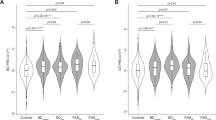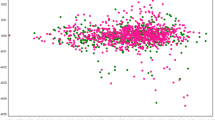Abstract
The orphan G protein-coupled receptor 78 (GPR78) gene lies within a region of chromosome 4p where we have previously shown linkage to bipolar affective disorder (BPAD) in a large Scottish family. GPR78 was screened for single-nucleotide polymorphisms (SNPs) and a linkage disequilibrium map was constructed. Six tagging SNPs were selected and tested for association on a sample of 377 BPAD, 392 schizophrenia (SCZ) and 470 control individuals. Using standard χ2 statistics and a backwards logistic regression approach to adjust for the effect of sex, SNP rs1282, located approximately 3 kb upstream of the coding region, was identified as a potentially important variant in SCZ (χ2 P=0.044; LRT P=0.065). When the analysis was restricted to females, the strength of association increased to an uncorrected allele P-value of 0.015 (odds ratios (OR)=1.688, 95% confidence intervals (CI): 1.104–2.581) and uncorrected genotype P-value of 0.015 (OR=5.991, 95% CI: 1.545–23.232). Under the recessive model, the genotype P-value improved further to 0.005 (OR=5.618, 95% CI: 1.460–21.617) and remained significant after correcting for multiple testing (P=0.017). No single-marker association was detected in the SCZ males, in the BPAD individuals or with any other SNP. Haplotype analysis of the case–control samples revealed several global and individual haplotypes, with P-values <0.05, all but one of which contained SNP rs1282. After correcting for multiple testing, two haplotypes remained significant in both the female BPAD individuals (P=0.038 and 0.032) and in the full sample of affected female individuals (P=0.044 and 0.033). Our results provide preliminary evidence for the involvement of GPR78 in susceptibility to BPAD and SCZ in the Scottish population.
This is a preview of subscription content, access via your institution
Access options
Subscribe to this journal
Receive 12 print issues and online access
$259.00 per year
only $21.58 per issue
Buy this article
- Purchase on Springer Link
- Instant access to full article PDF
Prices may be subject to local taxes which are calculated during checkout


Similar content being viewed by others
Accession codes
References
Craddock N, Khodel V, Van Eerdewegh P, Reich T . Mathematical limits of multilocus models: the genetic transmission of bipolar disorder. Am J Hum Genet 1995; 57: 690–702.
Berry N, Jobanputra V, Pal H . Molecular genetics of schizophrenia: a critical review. J Psychiatry Neurosci 2003; 28: 415–429.
Tsuang MT, Taylor L, Faraone SV . An overview of the genetics of psychotic mood disorders. J Psychiatr Res 2004; 38: 3–15.
Blackwood DH, He L, Morris SW, McLean A, Whitton C, Thomson M et al. A locus for bipolar affective disorder on chromosome 4p. Nat Genet 1996; 12: 427–430.
Le Hellard S, Lee AJ, Underwood S, Thomson PA, Morris SW, Torrance HS et al. Haplotype analysis and a novel allele sharing method refines a chromosome 4p locus linked to bipolar disorder and schizophrenia. 2005 (submitted).
Asherson P, Mant R, Williams N, Cardno A, Jones L, Murphy K et al. A study of chromosome 4p markers and dopamine D5 receptor gene in schizophrenia and bipolar disorder. Mol Psychiatry 1998; 3: 310–320.
Ewald H, Degn B, Mors O, Kruse TA . Support for the possible locus on chromosome 4p16 for bipolar affective disorder. Mol Psychiatry 1998; 3: 442–448.
Detera-Wadleigh SD, Badner JA, Berrettini WH, Yoshikawa T, Goldin LR, Turner G et al. A high-density genome scan detects evidence for a bipolar-disorder susceptibility locus on 13q32 and other potential loci on 1q32 and 18p11.2. Proc Natl Acad Sci USA 1999; 96: 5604–5609.
Williams NM, Rees MI, Holmans P, Norton N, Cardno AG, Jones LA et al. A two-stage genome scan for schizophrenia susceptibility genes in 196 affected sibling pairs. Hum Mol Genet 1999; 8: 1729–1739.
Lerer B, Segman RH, Hamdan A, Kanyas K, Karni O, Kohn Y et al. Genome scan of Arab Israeli families maps a schizophrenia susceptibility gene to chromosome 6q23 and supports a locus at chromosome 10q24. Mol Psychiatry 2003; 8: 488–498.
Als TD, Dahl HA, Flint TJ, Wang AG, Vang M, Mors O et al. Possible evidence for a common risk locus for bipolar affective disorder and schizophrenia on chromosome 4p16 in patients from the Faroe Islands. Mol Psychiatry 2004; 9: 93–98.
Evans KL, Le Hellard S, Morris SW, Lawson D, Whitton C, Semple CA et al. A 6.9 Mb high-resolution BAC/PAC contig of human 4p153–p161 a candidate region for bipolar affective disorder. Genomics 2001; 71: 315–323.
Gould TD, Manji HK . Signaling networks in the pathophysiology and treatment of mood disorders. J Psychosom Res 2002; 53: 687–697.
Gonzalez-Maeso J, Rodriguez-Puertas R, Meana JJ, Garcia-Sevilla JA, Guimon J . Neurotransmitter receptor-mediated activation of G-proteins in brains of suicide victims with mood disorders: selective supersensitivity of alpha(2A)-adrenoceptors. Mol Psychiatry 2002; 7: 755–767.
Thomson PA, Wray NR, Thomson AM, Dunbar DR, Grassie MA, Condie A et al. Sex-specific association between bipolar affective disorder in women and GPR50, an X-linked orphan G protein-coupled receptor. Mol Psychiatry 2005; 10: 470–478.
Lee DK, Nguyen T, Lynch KR, Cheng R, Vanti WB, Arkhitko O et al. Discovery and mapping of ten novel G protein-coupled receptor genes. Gene 2001; 275: 83–91.
Lee DK, Lynch KR, Nguyen T, Im DS, Cheng R, Saldivia VR et al. Cloning and characterization of additional members of the G protein-coupled receptor family. Biochim Biophys Acta 2000; 1490: 311–323.
Herman JP, Prewitt CM, Cullinan WE . Neuronal circuit regulation of the hypothalamo-pituitary-adrenocortical stress axis. Crit Rev Neurobiol 1996; 10: 371–394.
Rybakowski JK, Twardowska K . The dexamethasone/corticotropin-releasing hormone test in depression in bipolar and unipolar affective illness. J Psychiatr Res 1999; 33: 363–370.
Pariante CM, Miller AH . Glucocorticoid receptors in major depression: relevance to pathophysiology and treatment. Biol Psychiatry 2001; 49: 391–404.
Altamura AC, Boin F, Maes M . HPA axis and cytokines dysregulation in schizophrenia: potential implications for the antipsychotic treatment. Eur Neuropsychopharmacol 1999; 10: 1–4.
Weinstock M . Does prenatal stress impair coping and regulation of hypothalamic-pituitary-adrenal axis? Neurosci Biobehav Rev 1997; 21: 1–10.
Bromet EJ, Fennig S . Epidemiology and natural history of schizophrenia. Biol Psychiatry 1999; 46: 871–881.
Endicott J, Spitzer RL . A diagnostic interview: the schedule for affective disorders and schizophrenia. Arch Gen Psychiatry 1978; 35: 837–844.
Association AP . Diagnostic and Statistical Manual of Mental Disorders 4th edn. (DSM–IV). APA: Washington, DC, 1994.
World Health Organization. The ICD-10 Classification of Mental and Behavioural Disorders: Clinical Descriptions and Diagnostic Guidelines. WHO: Geneva, 1992.
Risch NJ . Searching for genetic determinants in the new millennium. Nature 2000; 405: 847–856.
Rozen S, Skaletsky H . Primer3 on the WWW for general users and for biologist programmers. Methods Mol Biol 2000; 132: 365–386.
Gordon D, Abajian C, Green P . Consed: a graphical tool for sequence finishing. Genome Res 1998; 8: 195–202.
Barrett JC, Fry B, Maller J, Daly MJ . Haploview: analysis and visualization of LD and haplotype maps. Bioinformatics 2005; 21: 263–265.
Wray NR . Allele frequencies and the r2 measure of linkage disequilibrium: impact on design and interpretation of association studies. Twin Res Hum Genet 2005; 8: 87–94.
Wall JD, Pritchard JK . Haplotype blocks and linkage disequilibrium in the human genome. Nat Rev Genet 2003; 4: 587–597.
Berrettini W . Evidence for shared susceptibility in bipolar disorder and schizophrenia. Am J Med Genet C 2003; 123: 59–64.
Craddock N, O'Donovan MC, Owen MJ . The genetics of schizophrenia and bipolar disorder: dissecting psychosis. J Med Genet 2005; 42: 193–204.
Holden C . Sex and the suffering brain. Science 2005; 308: 1574.
Zubenko GS, Hughes III HB, Stiffler JS, Brechbiel A, Zubenko WN, Maher BS et al. Sequence variations in CREB1 cosegregate with depressive disorders in women. Mol Psychiatry 2003; 8: 611–618.
Kirkwood BR, Sterne JAC . Essential Medical Statistics, 2nd edn. Blackwell Science Ltd: Malden, MA, 2003.
Cordell HJ, Clayton DG . A unified stepwise regression procedure for evaluating the relative effects of polymorphisms within a gene using case/control or family data: application to HLA in type 1 diabetes. Am J Hum Genet 2002; 70: 124–141.
Dudbridge F . Pedigree disequilibrium tests for multilocus haplotypes. Genet Epidemiol 2003; 25: 115–121.
Altschul SF, Gish W, Miller W, Myers EW, Lipman DJ . Basic local alignment search tool. J Mol Biol 1990; 215: 403–410.
Ng PC, Henikoff S . SIFT: predicting amino acid changes that affect protein function. Nucleic Acids Res 2003; 31: 3812–3814.
Cserzo M, Eisenhaber F, Eisenhaber B, Simon I . On filtering false positive transmembrane protein predictions. Protein Eng 2002; 15: 745–752.
Hulo N, Sigrist CJ, Le Saux V, Langendijk-Genevaux PS, Bordoli L, Gattiker A et al. Recent improvements to the PROSITE database. Nucleic Acids Res 2004; 32: D134–D137.
Blom N, Gammeltoft S, Brunak S . Sequence and structure-based prediction of eukaryotic protein phosphorylation sites. J Mol Biol 1999; 294: 1351–1362.
Blanchette M, Kent WJ, Riemer C, Elnitski L, Smit AF, Roskin KM et al. Aligning multiple genomic sequences with the threaded blockset aligner. Genome Res 2004; 14: 708–715.
Siepel A, Haussler D . Combining phylogenetic and hidden Markov models in biosequence analysis. J Comput Biol 2004; 11: 413–428.
Kent WJ, Sugnet CW, Furey TS, Roskin KM, Pringle TH, Zahler AM et al. The human genome browser at UCSC. Genome Res 2002; 12: 996–1006.
Karolchik D, Baertsch R, Diekhans M, Furey TS, Hinrichs A, Lu YT et al. The UCSC Genome Browser Database. Nucleic Acids Res 2003; 31: 51–54.
Kel AE, Gossling E, Reuter I, Cheremushkin E, Kel-Margoulis OV, Wingender E . MATCH: a tool for searching transcription factor binding sites in DNA sequences. Nucleic Acids Res 2003; 31: 3576–3579.
Wingender E, Chen X, Fricke E, Geffers R, Hehl R, Liebich I et al. The TRANSFAC system on gene expression regulation. Nucleic Acids Res 2001; 29: 281–283.
Consortium TIH . The international HapMap project. Nature 2003; 18: 789–796.
Akey J, Jin L, Xiong M . Haplotypes vs single marker linkage disequilibrium tests: what do we gain? Eur J Hum Genet 2001; 9: 291–300.
Jawaid A, Sham PC, Makoff AJ, Asherson PJ . Is haplotype tagging the panacea to association mapping studies? Eur J Hum Genet 2004; 12: 259–262.
Goring HH, Terwilliger JD, Blangero J . Large upward bias in estimation of locus-specific effects from genomewide scans. Am J Hum Genet 2001; 69: 1357–1369.
Wang WY, Barratt BJ, Clayton DG, Todd JA . Genome-wide association studies: theoretical and practical concerns. Nat Rev Genet 2005; 6: 109–118.
Acknowledgements
We would like to thank the Sanger Institute and the Genetics Core of the Wellcome Trust Clinical Research Facility at the Western General Hospital for carrying out the SNP genotyping; M Walker and M van Beck for assistance with clinical aspects of the study and ST Cooper for assistance in the preparation of the manuscript. A Tenesa acknowledges funding from Cancer Research UK. This work was supported by grants from the Medical Research Council. This work was supported by the UK Medical Research Council.
Author information
Authors and Affiliations
Corresponding author
Additional information
Supplementary Information accompanies the paper on the Molecular Psychiatry website (http://www.nature.com/mp)
Rights and permissions
About this article
Cite this article
Underwood, S., Christoforou, A., Thomson, P. et al. Association analysis of the chromosome 4p-located G protein-coupled receptor 78 (GPR78) gene in bipolar affective disorder and schizophrenia. Mol Psychiatry 11, 384–394 (2006). https://doi.org/10.1038/sj.mp.4001786
Received:
Revised:
Accepted:
Published:
Issue Date:
DOI: https://doi.org/10.1038/sj.mp.4001786
Keywords
This article is cited by
-
Neuro-psychopharmacological perspective of Orphan receptors of Rhodopsin (class A) family of G protein-coupled receptors
Psychopharmacology (2017)
-
The myelin-pathogenesis puzzle in schizophrenia: a literature review
Molecular Psychiatry (2008)
-
Association analysis of the chromosome 4p15–p16 candidate region for bipolar disorder and schizophrenia
Molecular Psychiatry (2007)



